
|
| Aren't these hedgehogs just the cutest? |
Today, you can test it out with a small scale bargello quilting project for a
tiny table topper. At first glance, it might seem a lot like the one that I
posted about in
part three of this series on math in sewing, but it comes with more
options (and being smaller, it's quicker to finish).
Because I'm still all about the math, I wanted to show how
variables affect the finished design. So what I've done is
present you with the building blocks to make several different designs out of
the same wedges of fabric, which in turn are created out of three different
fabric strips (although you have yet another option to use more). By changing
how many wedges you sew together and in what manner, you can vary the end
result.
It's actually your chance to design your own bargello project, which I think
is pretty cool, especially if you've never done one before. After all, how
often do you get the chance to design and do, for the first time,
at the same time?
Hey — it's also my holiday gift to you before I take a break from here!
Using the Ruler & Cutting the Wedges
I had three fabrics featuring hedgehogs from my
Lily and Loom collection
that I wanted to use for this project. (Two of them had to be cut twice to get
the five strips required.) If you want to have the most options for design
purposes, however, use five different fabrics.

|
| Cut and lay out five strips of fabric... |
The five strips are 2" by 35" wide; i.e., cut across the width of the
fabric.
You will also need (potentially) a backing fabric, some fusible fleece and
some binding. (Total amounts will depend on your chosen design.)

|
| Sew strips together... |
Sew the strips of fabric together with a 1/4" seam allowance and then press
all seams to one side.
Next, you'll want to establish the position for cutting the first wedge. For
this, you'll need to put the ruler down and align the
narrow end with the top edge of the finished panel. If you sewed
together strips of different lengths like I did, start at that end of the
panel to get that cleared out of the way.

|
| Wedge ruler shows that this panel is 7.5" high... |
By the way, when you lay out your panel of fabric and measure its height,
you may see something other than the 7.5" that I have here. Hopefully, it
won't vary by too much, but of course, any variance has to do with
what "1/4" seam allowance" works out to on your sewing machine, how well
you adhere to it, how thick your fabric is, and how well you pressed the
finished piece.
For the purposes of this project, it doesn't really matter how high this
panel is, so don't even worry about it. As long as it's the same all the way
across the fabric – i.e., you managed to keep your stitching
straight – you're good to go.
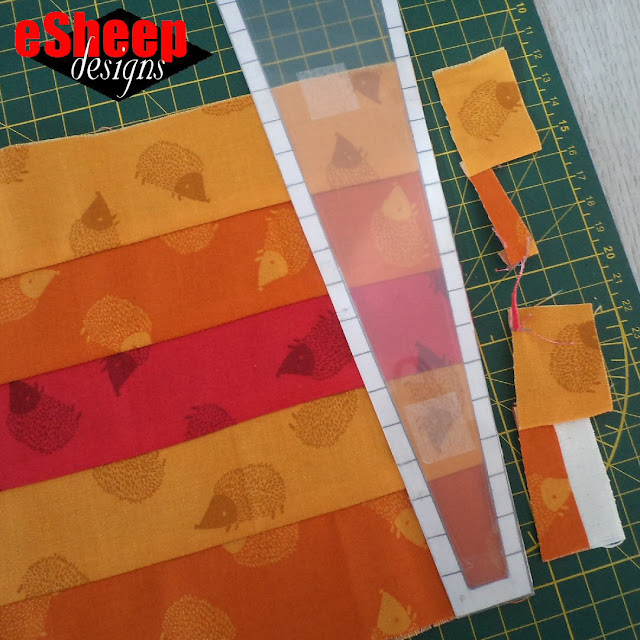
|
| Make the first cut... |
Let's get on with the cutting of the wedges. First thing is to cut away
the end piece. (I'm right handed, so I turned the whole mat around to cut
from the other direction.)
I did actually cut along the plastic template/ruler for this first
cut (you might want to put some double-sided tape onto the back of it to help keep it in place), but for all the others, I used my quilting ruler as the edge that I cut
along.

|
| Line up quilting ruler against edge of template... |
All you have to do is butt up the edge of the quilting ruler along the edge
of the wedge template, move it out of the way and make the cut.
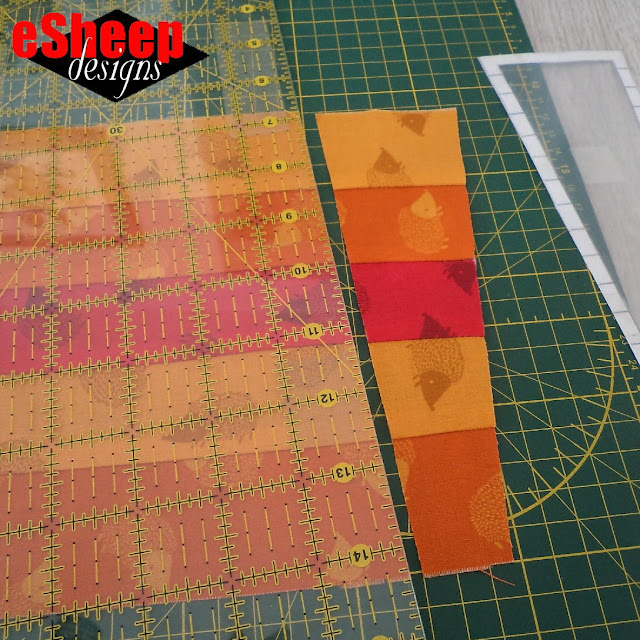
|
| Take away template and make the cut... |
Doing it this way, it is entirely feasible for you to make your wedge
ruler/template out of plain cardboard. Just trim it to the exact height that
you need – since you won't be able to see through it – to ensure that you're straight at both ends.

|
| Cut until you have 18 wedges... |
Speaking of both ends, remember as you make these cuts that the narrow end of
the plastic wedge ruler/template is always lined up with the edge of the
fabric. The wide end of the ruler will always extend beyond the fabric
as shown in the photos here.

|
| You should have enough material left over to cut a couple of straight strips like this... |
You can stop after cutting eighteen wedges. You should then have enough left
over to cut two strips, each 1.5" wide.
Now, just in case you don't relish the idea of sewing together strips in the
first place, here is a straight forward method that will work just as well.

|
| Cut wedges from regular fabric... |
You can use regular fabric. Of course, to create any interest, you'll have to
cut up at least two different fabrics, like so...

|
| Perfect for a couple of fat quarters... |
But the best part about doing it this way is that you can use fat quarters.
It's not bargello, but you still get to try out the wedge ruler.
With eighteen wedges and two straight strips, you can do quite a bit of
"designing". Here are some ideas to get your creative juices flowing.
OPTION 1: This is the first (obvious) arrangement; a simple
block of nine plus nine to create a lazy "s" curve.

|
| Nine plus nine arrangement... |
See the split in the middle? If you insert one of the straight strips there,
it will continue the alternating sequence of fabrics. (If you started
with five different fabrics, you won't have any issues with same
fabrics being adjacent.)
OPTION 2: Or you can use the second block of nine to be the
back of the first. This will give you a reversible finished item
that's a ideally sized for a night stand. (And if you start with
two sets of five fabrics – i.e., cut ten strips, 2" x 17" –
this option will give you two distinct looks.)
Just be careful when creating a back to back layout, because you need to mirror the other side.

|
| Arrangement of four plus five, one, five plus four... |
OPTION 3: Split the nine into blocks of four plus five at one
end (and then five plus four at the other) and insert the straight strip in
the middle. This results in a curve much like what I was trying to achieve
with my previous project.
OPTION 4: Similar idea to Option 2, do the block of four
plus one strip plus a block of five (or just four plus five) arrangement back
to back, eliminating the need for a separate backing. Again, if you start with
ten different strips at 2" x 17", this option will give you two distinct
reversible looks.
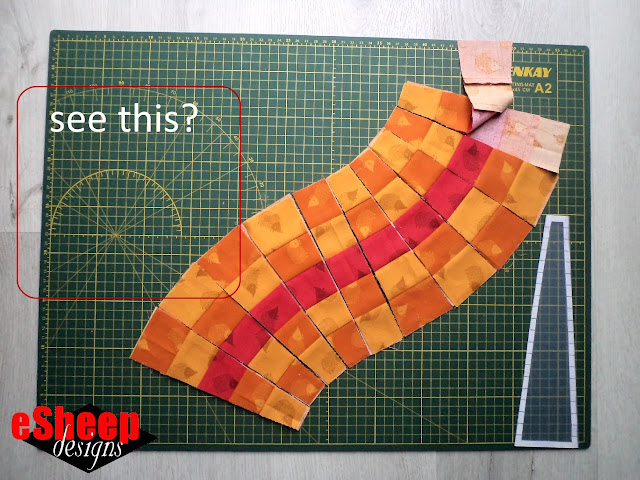
|
| Another option that won't require a separate backing fabric... |
Oh, see the part in the photo above that's inside the red square? What is
that? A protractor! I've never used this side of the cutting mat and didn't
realize it had its own protractor printed on it. (-‸ლ)
OPTION 5: You probably could have guessed that this one was
coming: a six block, plus one strip, plus another six block, plus one strip,
plus a final six block. This layout reminds me of a bat in flight.
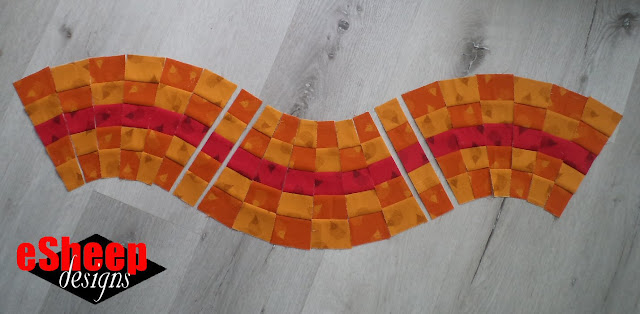
|
| A six block, straight strip, six block, straight strip and six block arrangement... |
I'm going to stop here and let you explore further how you might design
your own bargello project.
I've already described how to do the sewing and finishing of this type of
bargello table topper in my third post in this series, so please refer
back to it if you require more detail.
Sewing
After you have your desired design laid out into blocks, simply take two
adjacent wedges, put them right sides together and sew down the appropriate
edge with a 1/4" seam allowance. Press all seams to one side.

|
| Sewing together adjacent wedges... |
Continue sewing until each block is finished, then sew the blocks together.
It's important to keep pressing the seams as you go, and to press the entire
piece when you finish sewing.
By the way, you'd be the exception if all of your pieces lined up perfectly.
Don't be afraid to take out the seam ripper and redo any that are really
off, but otherwise, just go with the flow.
Quilting
After the wedges are stitched together, add some fusible fleece and a
backing and then quilt to your liking. I find that choice of fabric will
always determine how much I want to quilt something, as I may not want a nice
print to be covered over with quilting lines.

|
| I opted to quilt "around"... |
If you go with a design that incorporates some of the pieced wedges as a
backing (like options 2 and 4 above), stack the layers on top of one another
(with the fleece in between) and ensure that they are as even as they can
be. Whatever side you quilt on will show on the other side, so unless your
wedges are perfectly on top of one other, you may want to opt for something
that doesn't follow existing seam lines.
Binding
Don't take this as an absolute guarantee – because I obviously didn't
"test sew" all of the possible design variations that can arise from the
eighteen wedges above – but I completed a full size version of this
project (i.e., I used eighteen wedges plus one straight piece on one side)
and I was able to make enough 1.5"
bias binding out of an 11" square
of fabric.
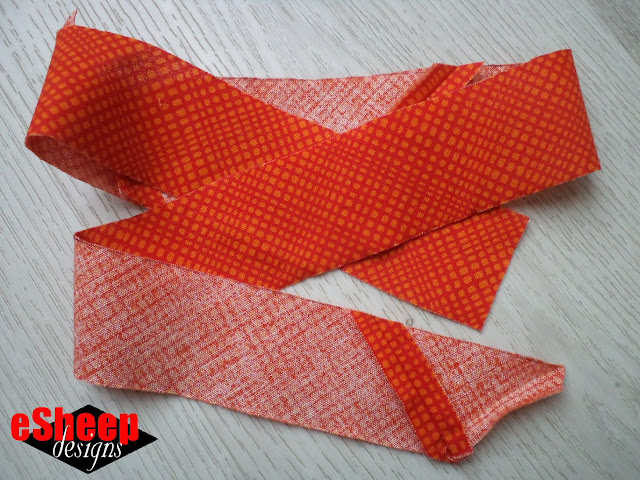
|
| Make your own binding... |
Given that the two ends of whatever design you end up making can be bound
with straight cut binding, as long as you also have an extra piece
of fabric measuring 3" x 8" (to yield two pieces 1.5" x 8") to bind the
ends, that 11" square should make enough bias binding to meet your
needs.
You may have guessed by now that I am not going to reveal what I did with
this project today; it's already been a VERY LONG POST. But I
will leave you with this little teaser photo, complete with hedgehog.

|
| Hedgehog following along the path of my tiny table topper... |
Perhaps you can take these next two weeks to create your own tiny table topper and then we can come back to compare notes on our respective projects.
Good luck and happy designing!





No comments:
Post a Comment
You have the power to brighten my day. Leave me a comment; I'd love to hear your thoughts... you can even remain ANONYMOUS! And rest assured that I acknowledge all comments, either here or via email. (That is, if you don't see a response from me here, I would have responded privately to the person.) Spam or generic comments with unrelated links, however, are promptly removed... and I may take appropriate action or report you to Google. Thanks for reading! (✿◠‿◠)